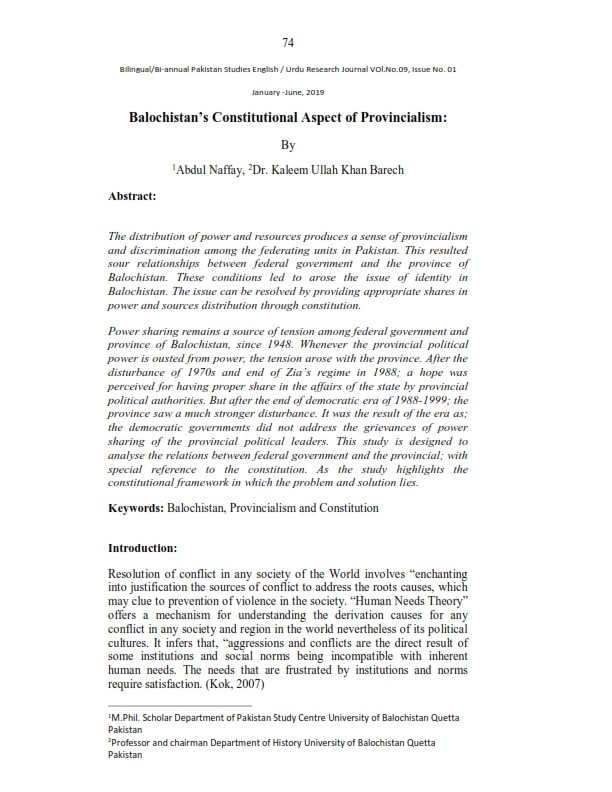Balochistan’s Constitutional Aspect of Provincialism
Keywords:
Balochistan, Provincialism and ConstitutionAbstract
The distribution of power and resources produces a sense of provincialism
and discrimination among the federating units in Pakistan. This resulted
sour relationships between federal government and the province of
Balochistan. These conditions led to arose the issue of identity in
Balochistan. The issue can be resolved by providing appropriate shares in
power and sources distribution through constitution.
Power sharing remains a source of tension among federal government and
province of Balochistan, since 1948. Whenever the provincial political
power is ousted from power, the tension arose with the province. After the
disturbance of 1970s and end of Zia’s regime in 1988; a hope was
perceived for having proper share in the affairs of the state by provincial
political authorities. But after the end of democratic era of 1988-1999; the
province saw a much stronger disturbance. It was the result of the era as;
the democratic governments did not address the grievances of power
sharing of the provincial political leaders. This study is designed to
analyse the relations between federal government and the provincial; with
special reference to the constitution. As the study highlights the
constitutional framework in which the problem and solution lies.
References
Abbasi. Federalism, Provincial Autonomy, and Conflicts. p. 31.
Article 143 of the constitution. Seen in Mansoor Akbar Kundi,
Constitutions: A Selective Study. (Karachi: Comprehensive Book
Service, 1995), p. 188.
Callard, Keith. Pakistan: A Political Study. (Oxford: Allen & Unwin,
. p. 159.
Craig Baxter. “Constitution Making: The Development of Federalism in
Pakistan” Asian Survey. December, 1974. 14:12, p. 1075.
Frederic Grare. “Pakistan: The Resurgence of Baluch Nationalism”.
Carnegie Papers (No: 65). January, 2006. p. 4.
Gulshan Majeed and Syed Muhammad Ammar Hamdani. “Issues and
Adjustment in Pakistan’s Federation”. Journal of Political Studies,
Vol. 22, Issue - 2, 2015, (615-628), p. 620.
http://www.dawn.com/wps/wcm/connect/dawn-content-library/dawn/
news/pakistan/provinces/03-violation-of-the-land-acquisition-actss-05?utm_source=
feedburner&utm_medium=feed&utm_campaign=Feed:+dawn/new
s/pakistan+(DAWN.C OM+-+Pakistan+News) (Last Accessed:
September 8, 2015).
Hussain Bukhari, “Resolving Balochistan Conflict”. p. 378.
Hussain, Ahmed. Politics and People’s Representation in Pakistan.
(Lahore: Ferozsons, 1974). p. 83.
K. Adeney. “The Limitations of Non-consociational Federalism: The
Example of Pakistan”, Ethno politics, Vol. 8, No. 1, 2009. p.87–
Kok, H. “Reducing Violence: Applying the Human Needs Theory to the
Conflict in Chechnya”. Review of International Law and Politics.
No: 3, (89-108). p. 91.
M. Mushtaq. Managing Ethnic Diversity and Federalism in Pakistan. In:
European Journal of Scientific Research, (2009). Vol. 33, No. 2,
pp. 279–294. Seen in, Abbasi. Federalism, Provincial Autonomy,
and Conflicts. p. 30.
Mansoor Akbar Kundi, Constitutions: A Selective Study. p. 191-194.
Roger Scruton, A Dictionary of Political Thought. (London: Macmillan,
. p. 170.
S. Baloch. The Balochistan Conflict: Towards a Lasting Peace.
(Islamabad: Pakistan Security Research Unit (PSRU), 2007). p. 12.
Saeed, Shafqat. Civil Military Relations in Pakistan: from Zulfiqar Ali
Bhutto to Benazir Bhutto. (Colorado: Westview Press, 1997). p. 21.
Syed Mujawar Hussain Shah. Federalism in Pakistan: Theory and
Practice. (Islamabad: Quaid-I-Azam University, 1994). p. 10.
Syed Shahid Hussain Bukhari, Yasmin Roofi and Syed Adnan Bukhar.
“Resolving Balochistan Conflict: A Human Needs Approach”.
Pakistan Journal of Social Sciences (PJSS) Vol. 35, No. 1.
(377-389). p. 378.
The article 142(c) said “a provincial assembly shall, and Parliament
(Majlis-e-Shoora) Shall not, have power to make laws with respect
to any matter not enumerated in either the Federal Legislative List
or the Concurrent Legislative List.” Seen in, Mansoor Akber
Kundi Arbab Mohammad Jahangir. “Federalism in Pakistan: Issues
and Adjustment”, Asian Affair. p. 35.
The six Points defined in 1966 were(i) a federal form of government ton
the basis of Lahore Resolution, (ii) federal powers over defence
and foreign affairs only and residuary powers to be vested in the
provinces: (iii) two separate freely convertible currencies or one
currency with guarantees against the flight of capital from one
province to another and separate banking reserve; (iv) unite to have
power of taxation and revenue collection; (v) two separate
accounts for the foreign exchange earnings of two wings; (v) a
separate militia or para-military force for east Pakistan. Seen in,
Mansoor Akber Kundi Arbab Mohammad Jahangir. “Federalism in
Pakistan: Issues and Adjustment”, Asian Affair. p. 34.
Waseem, Dr. Mohammad, Federalism in Pakistan, Asian Affairs, August,
Zubair Faisal Abbasi. Federalism, Provincial Autonomy, and Conflicts.
Islamabad: Centre for Peace and Development Initiatives (CPDI),
p. 30.



